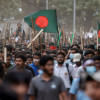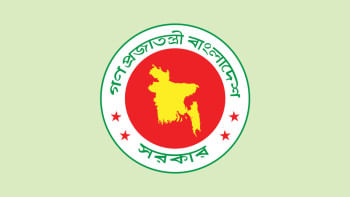Brushes and banners: Creative community leads rainy revolt in Dhaka

On a rain-soaked Friday morning in Dhanmondi, the air was thick with more than just moisture. Over a hundred people gathered in front of the Abahani Field on Sat Masjid Road, defying the downpour to raise their voices against what we see as a tide of injustice sweeping across Bangladesh. The scene was set for a powerful display of unity and resistance, as artistes from various disciplines came together to demand change.

Under the platform titled "Artistes Against Genocide and Oppression", a diverse group comprising visual artistes, photographers, performance artistes, musicians, poets, writers, researchers, architects, and art organisers, organised this rally of resistance. Their gathering was a response to the recent turmoil surrounding the quota reform protests, which have led to wholesale arrests and indiscriminate killings.

The numbers are staggering and disputed. According to different sources, between 150 and 266 people have died in connection with the protests. As of writing this report, at least 10,769 individuals, many of them students, have been arrested in 673 cases across the country since July 18. These figures have created a climate of fear and urgency that the artistes could no longer ignore or endure silently.

The society declared via a joint statement, "As members of the artistic community, we feel compelled to stand against the ongoing state injustices and oppression. Bangladesh has been bereft of a truly democratic environment for years. We've been stripped of our political and voting rights, and excluded from crucial national dialogues. Freedom of expression has been stifled by authoritarian laws, and those who dare to protest injustice face various forms of social and state oppression."

The creative community put forth three main demands: an immediate end to wholesale arrests and false cases against protesters, with the release of all detained students and civilians; the lifting of the curfew and removal of law enforcement and government-affiliated individuals from educational institutions to ensure a safe learning environment; accountability for indiscriminate killings, including an impartial investigation and the resignation of those in government responsible for these actions.

The rally was a vibrant display of resistance, featuring live performances, poetry recitations, and thought-provoking artwork. One particularly poignant piece was created by Rakibul Haque Emil, an animal rights activist. His work paid tribute to a victim who was brutally attacked, paraded through the streets on an APC, and then callously manhandled by police officers (dragged and tossed) – a haunting incident captured on widely circulated video footage.
Among the attendees was Barrister Rumeen Farhana, the central international affairs secretary of BNP, who wore a red sharee as a statement of solidarity. She emphasised, "This isn't about any specific group or political party. It's a protest of the masses. The 170 million people of Bangladesh stand united against a small group of opportunistic, government-biased individuals. I'm here as a citizen exercising my right to demand justice."

Rahnuma Ahmed, a renowned anthropologist and writer, also clad in a red sharee, offered her perspective: "This uprising is the culmination of years of frustration. The government's been exercising power with immense arrogance. Despite their rhetoric about the Liberation War, no political party has dishonoured our freedom, sovereignty and national interests as much as this one, particularly in favour of India."
"What we're witnessing is a collective outburst of long-suppressed anger and frustration," she remarked.
Ahmed added, "It was not one or two shots; the sheer volume of bullets fired, even from the air, is unprecedented. Such merciless killing has no place in today's world. We must remember that the students' protests began peacefully. It only turned violent when they were humiliated and attacked."

The human toll of the unrest was palpable in the words of one civilian attendee, who said, "I'm here as a father, standing alongside my daughter. We can no longer remain silent at home. This has grown beyond a student protest – it's about the safety of our children and the future of our nation. Parents everywhere are joining the streets, unable to bear the arrests, torture, and killings any longer."
He added poignantly, "You cannot kill our people, our children, and then expect to placate us with a reformed quota system. That's not how this works."

The protesters' artistic expressions were not limited to visual art. They participated in poem recitations, choruses, and live performances as forms of resistance. A particularly moving moment came when the crowd chanted "Awaaz Utha, Bangladesh" – the popular chorus from the rebel rap "Awaaz Utha" by Hannan Hossain Shimul. The rapper's recent unlawful detention on July 25 added fuel to the protesters' demands, as they called for his immediate release.

The organisers of this powerful display of solidarity included a diverse group of artistes and cultural figures: writer and artist Mustafa Zaman, photographer Imtiaz Alam Beg, musician Arup Rahee, musician Bithi Ghosh, curator and writer Amirul Rajiv, artist SN, photographer Raiyan Islam, artist and poet Shehzad Chowdhury, artist and poet Shawon Chishti, painter Kazi Tahsin Agaz Apurba, artist and curator A Ehsan, artist Raian Islam, photographer Mehbuba Mahjabin Hasan, painter Nuzhat Tabassum Anan, artist Sajan, artist Tanzim Iniat, artist Naeem Ul Hasan, curator and archivist Reesham Shahab Tirtho, architect and painter Asit Roy, artist Suborna Morsheda, painter Taposi and artist Afsana Sharmin Jhumpa.

As the rain continued to fall, the gathered artistes and citizens stood firm, their resolve unshaken. Through their art, their words, and their presence, they sent a clear message: the fight for justice, accountability, and true democracy in Bangladesh is far from over. In the face of oppression, they choose to create, to speak, and to stand united – a powerful reminder of the enduring strength of the human spirit in the pursuit of freedom and justice. The rain may have soaked their clothes, but it could not dampen their spirits or their determination to fight for a better, more just Bangladesh. After all, it was a rain of revolution.

 For all latest news, follow The Daily Star's Google News channel.
For all latest news, follow The Daily Star's Google News channel. 








Comments